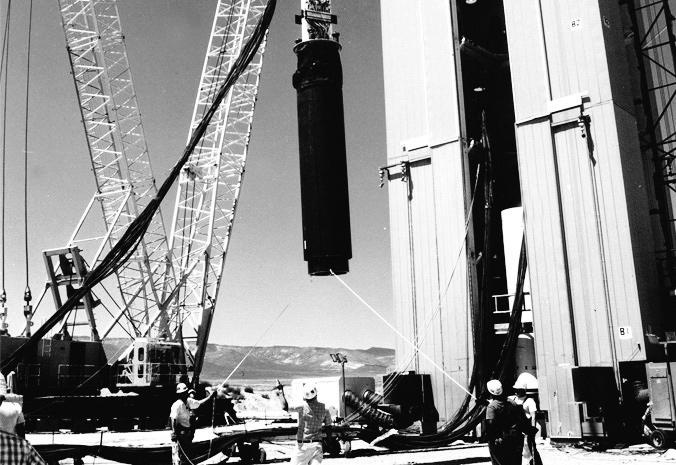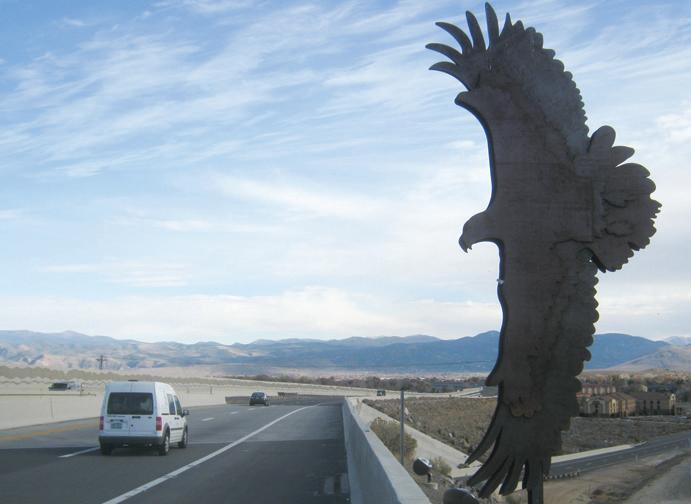
12 minute read
News
from Nov. 21, 2012
New area code coming
It’s not quite the same thing as getting a new U.S. House seat, but it signifies much the same thing—Nevada will get a new telephone area code in 2014.
Advertisement
The entire state was once area code 702. By December 1998, the state had grown enough for two codes. Clark County—where most Nevadans live—kept 702 and the rest of the state became 775. At that time, Nevada was the fastest growing state in the nation.
The state’s growth has now slowed down to a crawl, but it is still expected to grow enough to warrant a third code. The new code number, 725, will also be used in Clark County. However, residents of that metropolitan area will not be charged long distance rates for calls between the two codes.
Confederate State of Nevada?
The small group that is promoting Nevada’s secession from the union faces a few problems.
About 9,000 people have signed a petition posted on a White House website calling for the feds to “peacefully grant the State of Nevada to withdraw from the United States of America and create its own NEW government.” The language is the same as used on numerous other petitions for other states.
One problem is that the petition speaks in the name of the state, which is on the record against secession.
That record is another problem for secessionists. The Nevada Constitution says that “no power exists in the people of this or any other State of the Federal Union to dissolve their connection therewith or perform any act tending to impair[,] subvert, or resist the Supreme Authority of the government of the United States. The Constitution of the United States confers full power on the Federal Government to maintain and Perpetuate its existence [sic], and whensoever any portion of the States, or people thereof attempt to secede from the Federal Union, or forcibly resist the Execution of its laws, the Federal Government may, by warrant of the Constitution, employ armed force in compelling obedience to its Authority.”
That state language is almost certainly trumped by the federal First Amendment, which guarantees both redress of grievances and freedom of expression, but it is an obstacle for secessionists.
Then there’s the fact that there’s no evidence that Nevada public supports the notion. Nine thousand people is a third of a percentage point. Double it and it’s two thirds of a percentage point.
One problem the Nevada secessionists don’t face is that it’s not a welfare state. Most of those petitioning for secession are from Republican states that are subsidized by the feds—that is, they get more back in taxes than they pay. In fact, letting them secede would help bring down the deficit and balance the budget. Dana Milbank of the Washington Post wrote last week:
“It would be excellent financial news for those of us left behind if Obama were to grant a number of the rebel states their wish ‘to withdraw from the United States and create [their] own NEW government’ (the petitions emphasize ‘new’ by capitalizing it). Red states receive, on average, far more from the federal government in expenditures than they pay in taxes. The balance is the opposite in blue states. The secession petitions, therefore, give the opportunity to create what would be, in a fiscal sense, a far more perfect union. Among those states with large numbers of petitioners asking out: Louisiana (more than 28,000 signatures at midday Tuesday), which gets about $1.45 in federal largess for every $1 it pays in taxes; Alabama (more than 20,000 signatures), which takes $1.71 for every $1 it puts in; South Carolina (26,000), which takes $1.38 for its dollar; and Missouri (22,000), which takes $1.29 for its dollar.”
Nevada receives less back than it pays to the federal government, though the available information—compiled by the Tax Foundation—is a bit stale, dating back to 2005. For more, see http://tinyurl.com/bt6gj7l.
In 1941, there was a substantial effort to form a new state just northwest of Nevada, made up of Curry, Jackson, Josephine, and Klamath counties in Oregon and Del Norte, Modoc, and Siskiyou counties in California, to form a state called Jefferson. But that was not secession, just reconfiguration of existing states.
New WMDs
Conservatives want new nuclear weapons, raising the spectre of new Nevada tests
by Dennis Myers
The results of the election have preserved the status quo on the defunct project to build a dump for high level nuclear wastes in Nevada’s Yucca Mountain. But another nuclear issue threatens to intrude in the Silver State—revival of nuclear testing.
Conservative defense strategists say the U.S. needs to “update” its nuclear arsenal. They complain that under current policy, whether the U.S. develops a new generation of weapons depends not on U.S. security interests but on the actions of other nations.
Michaela Bendikova Heritage Foundation
On Dec. 8, the Nevada School of Medicine will offer free radiation screenings for Nevadans exposed to above-ground nuclear tests. Appointments must be scheduled. For information call 992-6887.
Though the U.S. Senate never approved the 1996 Comprehensive Test Ban Treaty, the nation has been in effective compliance with it as a matter of policy. Congress ordered a nine-month halt to testing in Nevada or elsewhere, and that halt has been renewed by every president since then, actions that critics of the treaty say keep the U.S. from adjusting to changing times.
“This month marks the 20th anniversary of the last test of U.S. nuclear weaponry. … [W]e are left with Cold War nuclear weapons, based on 1970s designs, intended to deter the Soviet Union,” Michaela Bendikova of the Heritage Foundation wrote last month. “These legacy weapons have high yields and are designed to take down hardened silos or command centers. Some U.S. policymakers seem to have missed the memo: The Soviet Union is no longer the paramount threat. We have to worry about new bad actors, for example North Korea or Iran.”
That last test was held on Sept. 23, 1992, and was code-named Divider. It was the last of an eighttest series. By then, 900 weapons had been detonated, most of them underground.
“Once the moratorium [on testing] went into effect,” said Los Alamos physicist Gary Wall last month, “there were many high-level discussions about what kind of science program we would build to take care of the stockpile without testing—this ramped up very quickly once it was clear the moratorium was serious.”
It is not necessary to test new weapons that are developed, but critics of the conservative effort believe pressure for testing would be intense.
Preston Truman, a Utah leader among downwinders—people victimized by radiation from earlier testing—said he objects not just to testing but to the development of new weapons.
“That was the whole purpose of a test ban in the first place—to prevent anyone from developing new nuclear weapons and weapons systems,” Truman said.
He also said that scientist have set up monitoring systems that would detect any testing of smaller weapons by rogue nations.
The weapon is lowered into the earth before the last nuclear test in Nevada in September 1992.
Ratification
Meanwhile, President Obama’s stated determination to get the comprehensive test ban ratified by the Senate takes on new force with his reelection, but also complicates the worldwide nuclear picture.
States that have not signed or ratified the treaty are China, Egypt, Iran, Israel, India, North Korea, Pakistan and United States.
“Finally, the new team and the Democratic Party, which has retained control of the Senate, will be tempted to push through a slew of international agreements, including the Comprehensive Nuclear Test Ban Treaty (CTBT),” wrote Center on International Cooperation strategic analyst W.P.S. Sidhu. “Were CTBTto be ratified, it would renew pressure on India to do the same. Similarly, the activist Obama administration is also likely to support negotiations for the Arms Trade Treaty and also revive efforts to stop the production of fissile material. Both of these will put India in a quandary, as it was relatively comfortable with the impasse in these areas.”
In September, Obama official Rose Gottemoeller said, “The last U.S. explosive nuclear test is not the only anniversary happening this week. Sixteen years ago, this Monday, the Comprehensive Nuclear Test-Ban Treaty (CTBT) was opened for signature. The United States signed the Treaty that same day.”
She said the Obama administration believes the refusal of the Senate to ratify the treaty was caused by doubts about verifiability, and believes those doubts can now be satisfied.
“As I have already outlined with regard to our nuclear deterrent, our extensive surveillance methods and computational modeling developed under the Stockpile Stewardship Program over the last 15 years have allowed our nuclear experts to understand how nuclear weapons work and age even better than when nuclear explosive testing was conducted, as our national laboratory
directors themselves affirmed to the Vice President. The Treaty’s verification regime has also grown exponentially over the last decade. Today, the International Monitoring System (IMS) is roughly 85 percent complete and when fully completed, there will be IMS facilities in 89 countries spanning the globe. At entry into force, the full body of technical data gathered via the International Monitoring System will be available for verification purposes to all states parties.”
At an annual conference last week of nations that have ratified the treaty, United Nations SecretaryGeneral Ban Ki-moon said, “To countries that remain outside of this treaty, I say: you are failing to live up to your responsibility as a member of the international community.”
The supporters of new weaponry frequently give the impression that politics is as much a factor for them as security. Bendikova, for instance, made her case by questioning the motives of opponents of her policy: “For those opposed to the U.S. maintaining superiority in nuclear arms, [no testing is] cause for celebration. But there will be no high-fiving among realists.”
In September 2002, when the Bush administration was reviewing nuclear testing readiness, the U.S. Energy Department said it would take 18 to 36 months to prepare the mothballed test site for a test. In addition, many experts in the field had retired.
Unfinished business
Meanwhile, as debate over the future of U.S. weapons goes on, the legacy of past U.S. weapons is still unsettled.
Recently an essay in Emmett, Idaho, Messenger Index accused the
federal government of dragging out compensation until downwind victims of testing radiation die off.
As if to emphasize the passage of time, in Colorado last week, a Rocky Flats Cold War Museum opened to commemorate the work of the Rocky Flats nuclear weapons laboratory in that state. It includes a display by photographer Carol Gallagher on the downwinders.
“I always wondered what happened to the people who lived near the testing areas,” she said. “So in my work I focused on workers, downwinders and atomic veterans.” Ω
Ban Ki-moon U.N. Secretary-General

Wingspan

Carson City is in the Eagle Valley, and a striking representation of that name greets drivers coming into the valley from the north. The sculptor’s name was unavailable at press time. For decades, Nevada highways were pretty Spartan and institutional. In recent years, federal, state, local and private money has allowed artists to make roadways less dismal.
Forget the ‘deal of the day’! Visit www.newsreview.com
Opiate addiction is a chronic and re-occurring pattern of physical and behavioral reactions. Without professional help, few escape. WE CAN HELP
The Life Change Center has the experience and trained staff to guide you through the process. Whether you require medication assistance or not, we offer respectful treatment designed around your goals. TAkE THAT STEP. MAkE THAT CHANgE. TODAY.
The Life Change Center is a 501(c)3 corporation. We accept ALL types of Medicaid and will assist with other insurance billing.
The Life Change Center
1755 Sullivan Lane • Sparks NV 89431 Phone (775)355-7734 Fax (775)355-7759
(Just past Greenbrae on Sullivan Lane, take the #2 or12 bus)
Think Free

Off the beaten track
A book written by local writer and professor Suzanne Roberts was given the top award for literature by the 2012 National Outdoor Book Awards (NOBA).
Roberts’ book, Almost Somewhere: Twenty-Eight Days on the John Muir Trail, documents her month-long journey through the Sierra Mountains in 1993, and addresses gender dynamics in the context of the environment.
The NOBA website states, “What emerges is a revealing and insightful coming-of-age portrait of women of the post baby boom generation. … This is life in an outdoor setting from a feminine perspective: anxiety over strange men met along the way and the challenges of long days on the trail.”
Roberts teaches at Lake Tahoe Community College and Sierra Nevada College, and has written several poetry books. She received a doctorate from the University of Nevada, Reno’s Literature and Environment Program, and National Geographic Traveler magazine called her “the next great travel writer.”
Coffee grounds
A study released this month by researchers at Britain’s Kew Gardens found that certain coffee crops were at risk for eradication by 2080 due to climate change. According to the study, farmers would have to continuously move crops in order to avoid changes in temperature that would kill particular types of coffee plants— most notably Arabica, which accounts for more than 70 percent of coffee beans on the market. Arabica is grown in several African countries, including Sudan and Ethiopia. The Kew study predicted that 65 percent of existing Arabica locations would be unable to grow the crops by 2080. London publication The Telegraph reported that for places in Sudan, this could happen by 2020.
The worst case scenario would render 100 percent of those locations unusable by 2080. The Telegraph article noted that new locations for growing Arabica were being sought.
Robusta, another type of coffee plant cultivated primarily in Greece and Turkey, is less sensitive to environmental changes, but is considered more bitter than Arabica and is therefore less popular among many Western coffee drinkers.
—Ashley Hennefer
ashleyh@newsreview.com
ECO-EVENT
Learn how to maintain succulents indoors during the winter season at a workshop hosted by the Rail City Garden Center. Cost includes succulents and a container, and will vary depending on succulents used. Soil will be provided, and participants can bring their own containers. Workshops will be held on Dec. 1, 11 a.m., and Dec. 2, 1 p.m. 1720 Brierley Way, Sparks. Call 355-1551 to RSVP.
Got an eco-event? Contact ashleyh@newsreview.com. Visit www.facebook.com/RNRGreen for more.









